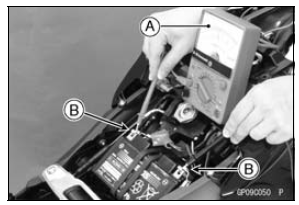

Special Tool - Hand Tester: 57001-1394
Charging Voltage 

If the charging voltage is kept between the values given in the table, the charging system is considered to be working normally.
If the charging voltage is much higher than the values specified in the table, the regulator/rectifier is defective or the regulator/rectifier leads are loose or open.
If the charging voltage does not rise as the engine speed increases, then the regulator/rectifier is defective or the alternator output is insufficient for the loads. Check the alternator and regulator/rectifier to determine which part is defective.
 Alternator Rotor Installation
Alternator Rotor Installation Alternator Inspection
Alternator InspectionInterlock Operation Inspection
Raise the rear wheel off the ground with the stand [A].
1st Check
Start the engine to the following conditions
Condition:
Transmission Gear → 1st Position
Clutch Lever → Release
Sidestand → Down or Up
Turn the ignition switch to ON and push the starter butto ...
Windshield and Other Plastic Parts
After washing use a soft cloth to
gently dry plastic parts. When dry,
treat the windshield, headlight lens,
and other nonpainted plastic parts with
an approved plastic cleaner/polisher
product.
NOTICE
Plastic parts may deteriorate
and break if they come in contact
with chemical substances
...
Wheel Rotation Sensor Rotor Inspection
Remove:
Wheels (see Front/Rear Wheel Removal in the
Wheels/Tires chapter)
Brake Disc Mounting Bolts [A]
Sensor Rotor [B]
Front Wheel [C]
Rear Wheel [D]
Visually inspect the wheel rotation sensor rotor.
If the rotor is deformed or damaged (chipped teeth [A]),
replace the ...